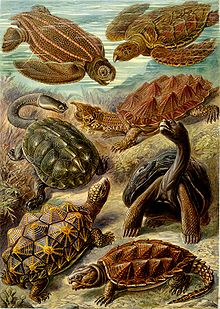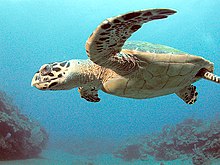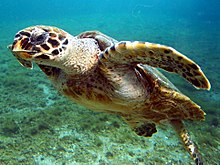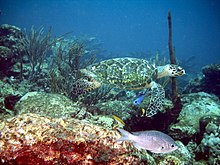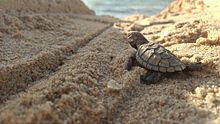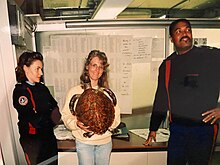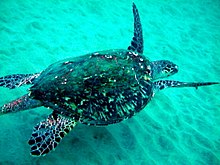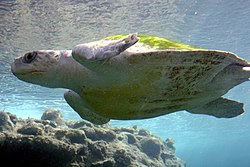
Sea turtles, sometimes called marine turtles, are reptiles of the order Testudines and of the suborder Cryptodira. The seven existing species of sea turtles are the flatback, green, hawksbill, leatherback, loggerhead, Kemp's ridley, and olive ridley. Six of the seven sea turtle species, all but the flatback, are present in U.S. waters, and are listed as endangered and/or threatened under the Endangered Species Act. All but the flatback turtle are listed as threatened with extinction globally on the IUCN Red List of Threatened Species. The flatback turtle is found only in the waters of Australia, Papua New Guinea, and Indonesia.

Cheloniidae is a family of typically large marine turtles that are characterised by their common traits such as, having a flat streamlined wide and rounded shell and almost paddle-like flippers for their forelimbs. They are the only sea turtles to have stronger front limbs than back limbs. The six species that make up this family are: the green sea turtle, loggerhead sea turtle, olive ridley sea turtle, hawksbill sea turtle, flatback sea turtle and the Kemp's ridley sea turtle.

The leatherback sea turtle, sometimes called the lute turtle, leathery turtle or simply the luth, is the largest of all living turtles and the heaviest non-crocodilian reptile, reaching lengths of up to 2.7 metres and weights of 500 kilograms (1,100 lb). It is the only living species in the genus Dermochelys and family Dermochelyidae. It can easily be differentiated from other modern sea turtles by its lack of a bony shell; instead, its carapace is covered by oily flesh and flexible, leather-like skin, for which it is named. Leatherback turtles have a global range, although there are multiple distinct subpopulations. The species as a whole is considered vulnerable, and some of its subpopulations are critically endangered.

The olive ridley sea turtle, also known commonly as the Pacific ridley sea turtle, is a species of turtle in the family Cheloniidae. The species is the second-smallest and most abundant of all sea turtles found in the world. L. olivacea is found in warm and tropical waters, primarily in the Pacific and Indian Oceans, but also in the warm waters of the Atlantic Ocean.

The loggerhead sea turtle is a species of oceanic turtle distributed throughout the world. It is a marine reptile, belonging to the family Cheloniidae. The average loggerhead measures around 90 cm (35 in) in carapace length when fully grown. The adult loggerhead sea turtle weighs approximately 135 kg (298 lb), with the largest specimens weighing in at more than 450 kg (1,000 lb). The skin ranges from yellow to brown in color, and the shell is typically reddish brown. No external differences in sex are seen until the turtle becomes an adult, the most obvious difference being the adult males have thicker tails and shorter plastrons than the females.
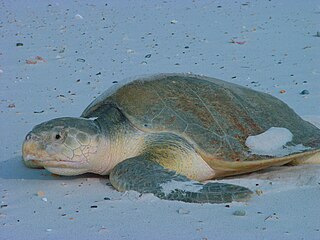
Kemp's ridley sea turtle, also called the Atlantic ridley sea turtle, is the rarest species of sea turtle and is the world's most endangered species of sea turtle. It is one of two living species in the genus Lepidochelys. The species primarily occupies habitat around the Gulf of Mexico though their migrations into the Atlantic are being affected by rising temperatures. Kemp's ridley sea turtles are currently listed as endangered under the Endangered Species Act (ESA), and current conservation efforts attempt to rebuild population numbers. Human activity, including but not limited to habitat destruction, climate change, and oil spills, threaten populations.

The green sea turtle, also known as the green turtle, black (sea) turtle or Pacific green turtle, is a species of large sea turtle of the family Cheloniidae. It is the only species in the genus Chelonia. Its range extends throughout tropical and subtropical seas around the world, with two distinct populations in the Atlantic and Pacific Oceans, but it is also found in the Indian Ocean. The common name refers to the usually green fat found beneath its carapace, due to its diet strictly being seagrass, not to the color of its carapace, which is olive to black.

The Australian flatback sea turtle is a species of sea turtle in the family Cheloniidae. The species is endemic to the sandy beaches and shallow coastal waters of the Australian continental shelf. This turtle gets its common name from the fact that its shell has a flattened or lower dome than the other sea turtles. It can be olive green to grey with a cream underside. It averages from 76 to 96 cm in carapace length and can weigh from 70 to 90 kg. The hatchlings, when emerging from nests, are larger than other sea turtle hatchlings when they hatch.

Turtling is the hunting of turtles. Turtling has been a part of human culture since as far back as the middle of the first millennium BC, where sea turtles such as the hawksbill sea turtle were eaten as delicacies in countries such as China. While consumption and hunting of turtles is less common than it was in the past, this practice is still a part of communities throughout the globe, whether done legally or illegally.

Tortoiseshell or tortoise shell is a material produced from the shells of the larger species of tortoise and turtle, mainly the hawksbill sea turtle, which is a critically endangered species according to the IUCN Red List largely because of its exploitation for this trade. The large size, fine color, and unusual form of the hawksbill's scutes make it especially suitable. The distinctive patterning is referred to in names such as the tortoiseshell cat, several breeds of guinea pig, and the common names of several species of the butterfly genera Nymphalis and Aglais, and some other uses.
The Jiquilisco Bay Biosphere Reserve is located on the southeast Pacific coast of El Salvador, in the department of Usulután. Jiquilisco Bay's mangrove-lined inlets and bay host the largest abundance of coastal-marine birds in the El Salvador, many of which are threatened or endangered. Over 80 species of migratory birds visit the area to feed on the bay's fish, which include species such as snook, red snapper and corvina. The natural environment of Bahia Jiquilisco has recently led to an increase in eco-tourism in the area.
The Padre Ramos Estuary Natural Reserve is located on the northwest Pacific coast of Nicaragua, in the municipality El Viejo in the department of Chinandega. It is one of 78 protected areas of Nicaragua and is managed by Ministry of the Environment and Natural Resources (MARENA). Estero Padre Ramos consists of a large mangrove estuary surrounded by several small beach communities, the largest of which is the town of Padre Ramos. The area's natural environment is home to a number of species of migratory and resident birds, fishes, crustaceans, sea turtles and other wildlife. While increasing in popularity as a tourist destination, tourism remains relatively well controlled in the area.
João Vieira and Poilão Marine National Park is a national park in Guinea-Bissau. It was established in August 2000. It covers an area of 495.0 square kilometres (191.1 sq mi) and includes the uninhabited islands of João Vieira, Cavalos, Meio and Poilão, in the southeastern part of the Bijagós Archipelago. The beaches of the islands are frequented by the sea turtle species Chelonia mydas, Eretmochelys imbricata and Lepidochelys olivacea.

Threats to sea turtles are numerous and have caused many sea turtle species to be endangered. Of the seven extant species of sea turtles, six in the family Cheloniidae and one in the family Dermochelyidae, all are listed on the IUCN Red List of Endangered Species. The list classifies six species of sea turtle as "threatened", two of them as "critically endangered", one as "endangered" and three as "vulnerable". The flatback sea turtle is classified as "data deficient" which means that there is insufficient information available for a proper assessment of conservation status. Although sea turtles usually lay around one hundred eggs at a time, on average only one of the eggs from the nest will survive to adulthood. While many of the things that endanger these hatchlings are natural, such as predators including sharks, raccoons, foxes, and seagulls, many new threats to the sea turtle species are anthropogenic.

Washington Slagbaai National Park is a national park and ecological reserve on the northwestern part of the island of Bonaire in the Caribbean Netherlands. The 5,643 hectares (21.79 sq mi) park covering approximately a fifth of the island of Bonaire is managed by STINAPA Bonaire, a non-profit foundation, on behalf of the Bonaire government. Established in 1969, Washington Slagbaai National Park was the first nature reserve to be established in the former Netherlands Antilles.

The Lampi Island Marine National Park is a marine national park in Myanmar covering 79.09 sq mi (204.8 km2). It was established in 1996. It encompasses Lanbi Island and several smaller islands in the Mergui Archipelago, comprising coral reefs, seagrass beds, mangroves, sand dunes and tropical evergreen forest up to an elevation of 1,493 ft (455 m). The national park is an Important Bird Area and one of the ASEAN Heritage Parks. The characteristics of the Marine National Park are the tropical evergreen rainforest, the vast coral reef systems that protect a wide range of aquatic ecosystems, and significant biodiversity in this area. Access is restricted to daytime visits.

The Gnaraloo Turtle Conservation Program (GTCP) is an environmental organisation based at the Gnaraloo pastoral station and run by the Gnaraloo Wilderness Foundation, a not-for-profit organisation. The aim of the GTCP is to identify, monitor and protect the nesting beaches of loggerhead sea turtles found at two locations on the Gnaraloo coastline. These two rookeries contribute to the South-East Indian Ocean subpopulation of loggerhead turtles, with other major nesting sites for this sub-population at Dirk Hartog island and Exmouth. This is within the southern boundaries of the Ningaloo Coast marine area, a UNESCO World Heritage Site.
The St. Croix East End Marine Park (STXEEMP) was established to "protect territorially significant marine resources, and promote sustainability of marine ecosystems, including coral reefs, sea grass beds, wildlife habitats and other resources, and to conserve and preserve significant natural areas for the use and benefit of future generations." It is the U.S. Virgin Islands’ first territorially designated and managed marine protected area (MPA).
Worldwide, hundreds of thousands of sea turtles a year are accidentally caught in shrimp trawl nets, on longline hooks and in fishing gill-nets. Sea turtles need to reach the surface to breathe, and therefore many drown once caught. Loggerhead and hawksbill turtles are particularly vulnerable. Nearly all species of sea turtle are classified as Endangered. They are killed for their eggs, meat, skin and shells. They also face habitat destruction. Climate change has an impact on turtle nesting sites. As fishing activity expands, this threat is more of a problem.
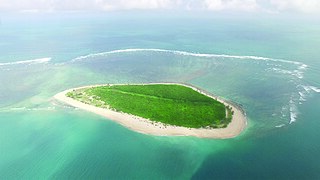
Ilha do Fogo, or Fire Island, is a remote, 3.5 km circumference island off the Zambezia Province coastline in northern Mozambique. It forms part of the Primeiras and Segundas Archipelago, within Africa's most extensive coastal marine protected area. The private island is encircled by coral-rich reefs on the island's south side and seagrasses on the north. It has 150 km of unexplored reef, with abundant and diverse marine life.



